
By Christopher Mah - Smithsonian National Museum of Natural History
September 22, 2014
This web log was adapted from a recent post on Chris' blog, Echinoblog ![]() . You can check out the full article here
. You can check out the full article here ![]() .
.
Owing to a fantastic combination of various technologies: deep-sea submersibles, high-definition cameras, quick and efficient Internet transmission, and the wonder of social media, not only do we have LIVE streams of deep-sea biology and exploration via NOAA Ship Okeanos Explorer, but we have the ability for almost anyone to tune and watch discoveries as they happen!
The starfish you encounter on these dives are not exactly commonplace. Starting to learn about them first entails knowing which ones are which – not an easy task given how poorly known some of these species are. Some of these have never been seen alive! And that's where I come in.
I’m one of the world’s few specialists who work on the diversity and evolution of sea stars, especially those in the deep sea. I’m able to put together the “homework” on various species from what is known to what has been seen by other scientists via Okeanos Explorer.
Below is a list of starfish species that we have seen during this expedition so far. It is biased by what I've been able to identify and the limits of the known science of each species. So, yes, we will still probably see things that are not on this post. And eventually, these things will see publication, as many are new records.
These species mainly exist in the North Atlantic along the east coast of North America. Some of the genera (e.g., Novodinia, Hymenaster, Pteraster) occur worldwide, so you'll see them in deep-sea pictures in many places. Some, such as Porania pulvillus, may also occur in very shallow water, which is unusual. But you can’t necessarily expect to find all of these species in say, Hawaii or even the nearby Gulf of Mexico.
Where species occur is often a funny thing in biology, likely dependent on a number of factors that make those places suitable for a specific species.
My thanks in advance to Dr. Chris Kellogg, Carina M. Gsottbauer, and the members of the Facebook Underwater Screengrab Group ![]() for their diligence!
for their diligence!
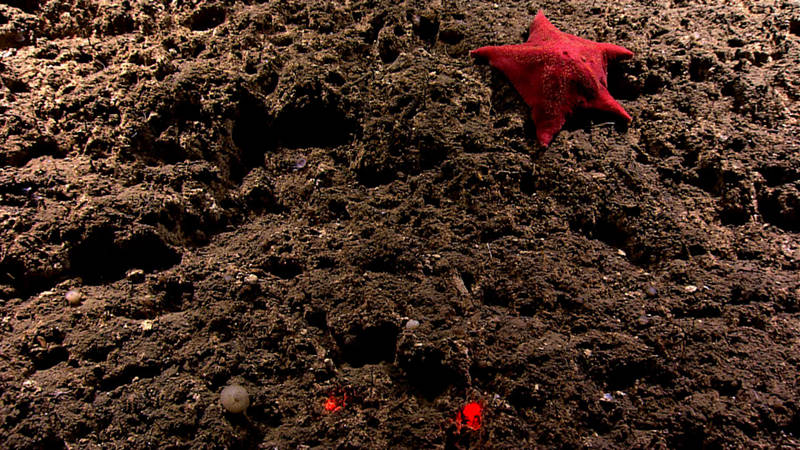
We don't know much about this species. The noted American zoologist Addison Verrill described this species in 1878, but sadly, our knowledge of this unusual animal ends there. Its living color wasn't even really known until recently. The body form in these is very unusual, with a very fleshy tissue which has the texture of a mango.
Specimens of this species lack any color, which is why seeing them alive is so crucial. Last year, we saw what I believe to be another individual of the same species, but it was a different color. So is one a new species? Or could the body color simply be variation? Some sea stars body color may vary by what they eat, suggesting some possibilities. This is where physical specimens are needed to examine the body and perhaps extract DNA to study the possibility that there could be separate species being seen. Image courtesy of the NOAA Office of Ocean Exploration and Research, Exploring Atlantic Canyons and Seamounts 2014. Download larger version (jpg, 2.1 MB).
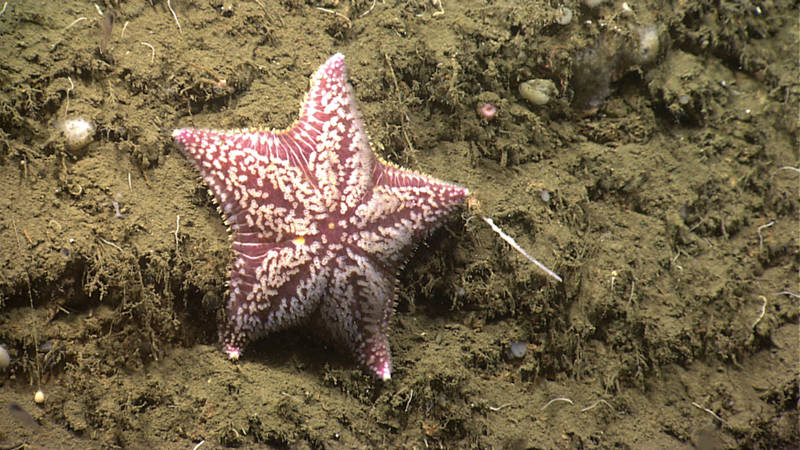
Interestingly, there is a shallow-water individual (from Norway) of what I think is the same species with a similar pattern, but different color! Based on the museum specimens, morphologically, these are nearly indistinguishable, but does this indicate a separate species? Image courtesy of the NOAA Office of Ocean Exploration and Research, Exploring Atlantic Canyons and Seamounts 2014. Download larger version (jpg, 1.6 MB).
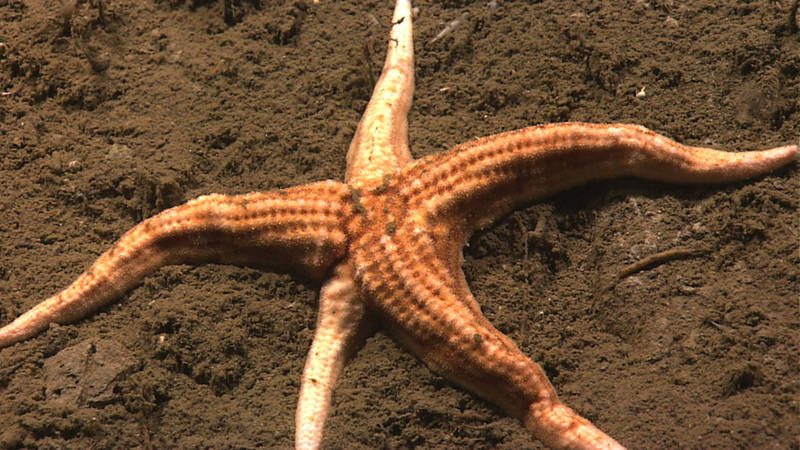
This is by far one of the most commonly encountered species during the Okeanos Explorer expeditions in the North Atlantic. We don't know much about the actual biology of this species. We don't know anything about howwhat it eats or what/how it reproduces or even anything about its ecology. But N. forcipatus does seem to very abundant on the sea bottom. Two different colors are observed for this species, a darker, brown one and a lighter, white one. It is unclear what these colors might represent.
The genus Neomorphaster also occurs in the eastern Atlantic, in the deeps off Europe. These are deep-sea members of what is mostly a Southern Hemisphere group ![]() , the Stichasteridae. Image courtesy of the NOAA Office of Ocean Exploration and Research, Exploring Atlantic Canyons and Seamounts 2014. Download larger version (jpg, 1.6 MB).
, the Stichasteridae. Image courtesy of the NOAA Office of Ocean Exploration and Research, Exploring Atlantic Canyons and Seamounts 2014. Download larger version (jpg, 1.6 MB).
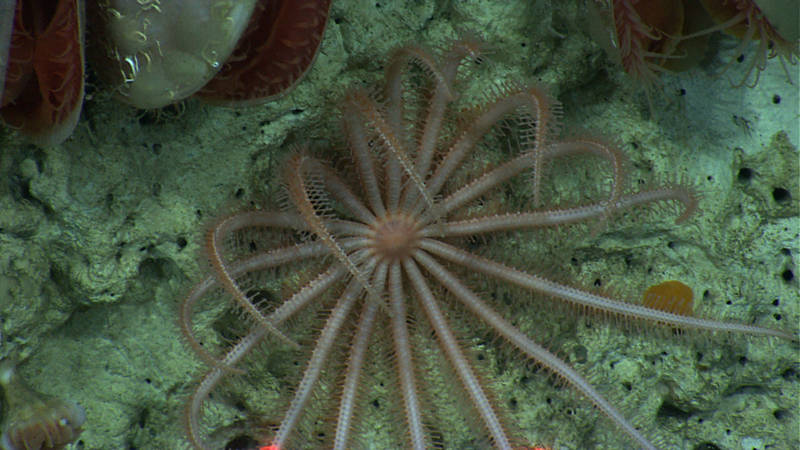
Despite their very unusual appearance, brisingids are proper sea stars, which have a very unusual life mode and body form. Brisingids use their multiple arms (often six to 20) which are covered with spines to capture tiny prey, often tiny crustaceans, and other food as it is carried by on water currents.
Food is captured by tiny structures known as pedicellariae. These are wrench-shaped claws which cover the spines and act as a kind of “velcro” to grab onto food. Once caught food is then moved down to the mouth via the tube feet. There are many species of brisingids in the deep-sea but only a few are recognizable from pictures.
You can learn more about brisingids here ![]() and here
and here ![]() . Image courtesy of the NOAA Office of Ocean Exploration and Research, Exploring Atlantic Canyons and Seamounts 2014. Download larger version (jpg, 1.5 MB).
. Image courtesy of the NOAA Office of Ocean Exploration and Research, Exploring Atlantic Canyons and Seamounts 2014. Download larger version (jpg, 1.5 MB).
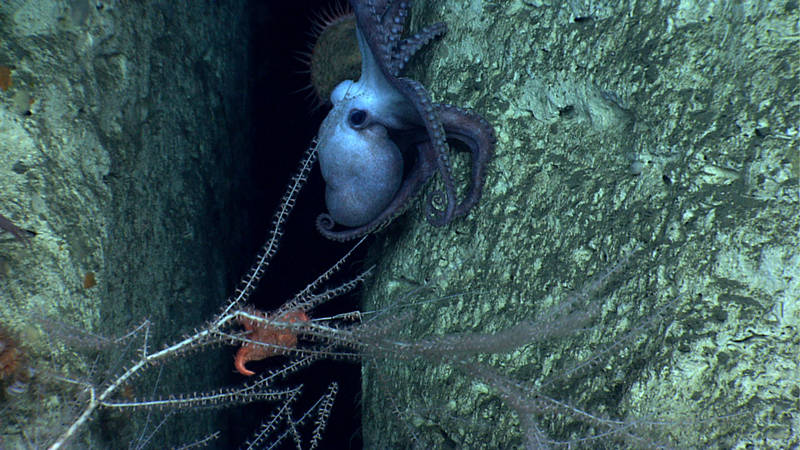
Evoplosoma, a deep-sea octocoral predator ![]() , is often seen feeding on various bamboo "corals" (i.e., members of the Isididae). There are several species of this genus in this region and it is difficult to make the call on these from pictures.
, is often seen feeding on various bamboo "corals" (i.e., members of the Isididae). There are several species of this genus in this region and it is difficult to make the call on these from pictures.
In the image above, do you see all those bare branches on this bamboo coral? That's Evoplosoma chowing down on the "meat" of the coral. It’s not unusual to see them climbing high up into the branches of such a colony. Image courtesy of the NOAA Office of Ocean Exploration and Research, Exploring Atlantic Canyons and Seamounts 2014. Download larger version (jpg, 1.8 MB).
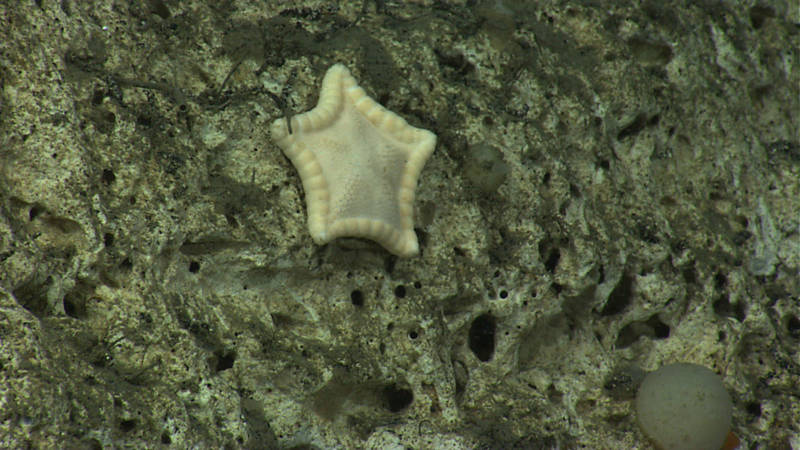
A so-called "cookie star," this species might be the shallower-water C. granularis or maybe something else? Likely, feeding on encrusting organisms or the "goo" on the substrate, but we really don't know. Image courtesy of the NOAA Office of Ocean Exploration and Research, Exploring Atlantic Canyons and Seamounts 2014. Download larger version (jpg, 1.5 MB).
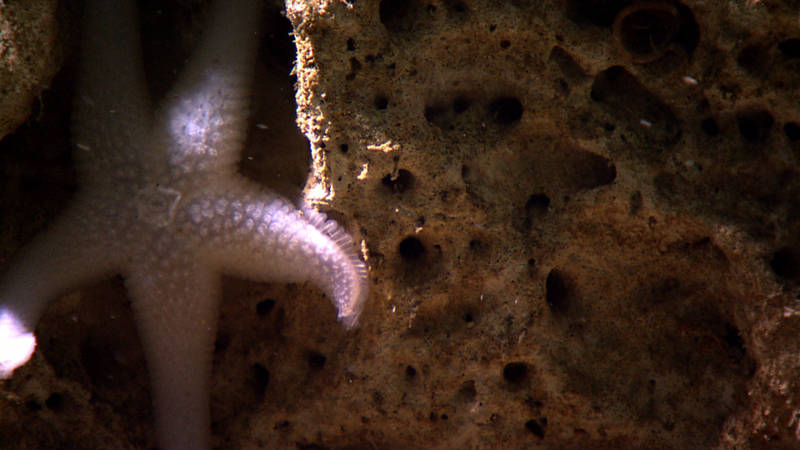
Another rarely encountered species. I haven't even quite figured out what this one is yet, but it has what looks to be an osculum, i.e., an opening on the central disk to allow water onto the body surface. Image courtesy of the NOAA Office of Ocean Exploration and Research, Exploring Atlantic Canyons and Seamounts 2014. Download larger version (jpg, 1.5 MB).
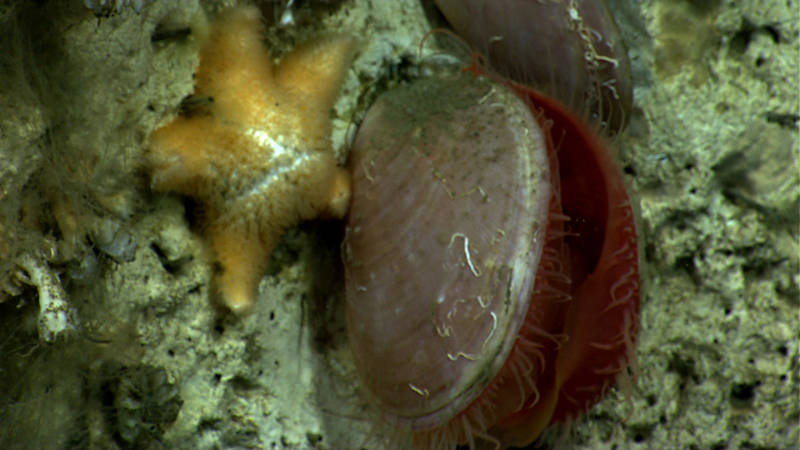
I wasn’t sure what this one was for certain. But it has spines along the surface that suggests a Lophaster, a widespread cold-water group. We'll have to keep our eyes open for more of these… Image courtesy of the NOAA Office of Ocean Exploration and Research, Exploring Atlantic Canyons and Seamounts 2014. Download larger version (jpg, 1.3 MB).
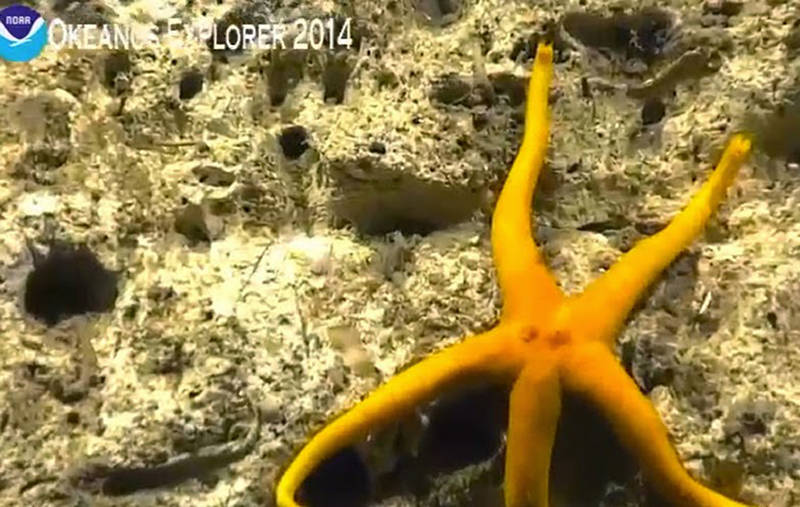
This genus, Henricia, is a huge mess for taxonomists (i.e., people who describe new species and new diversity). Why? Because these starfishes are all VERY similar in appearance to one another on a widespread scale! There are at least two species in this region.
Species in this group occur all around the world. But even in a very specific area, they can be nearly identical in appearance. So, unfortunately, unless the species is highly unusual (has more than five arms, etc.), these are quite difficult to tell apart. Image courtesy of the NOAA Office of Ocean Exploration and Research, Exploring Atlantic Canyons and Seamounts 2014. Download image (jpg, 93 KB).